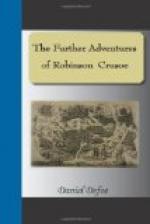The road all on this side of the country is very populous, and is full of potters and earth-makers—that is to say, people, that temper the earth for the China ware. As I was coming along, our Portuguese pilot, who had always something or other to say to make us merry, told me he would show me the greatest rarity in all the country, and that I should have this to say of China, after all the ill-humoured things that I had said of it, that I had seen one thing which was not to be seen in all the world beside. I was very importunate to know what it was; at last he told me it was a gentleman’s house built with China ware. “Well,” says I, “are not the materials of their buildings the products of their own country, and so it is all China ware, is it not?”—“No, no,” says he, “I mean it is a house all made of China ware, such as you call it in England, or as it is called in our country, porcelain.”—“Well,” says I, “such a thing may be; how big is it? Can we carry it in a box upon a camel? If we can we will buy it.”—“Upon a camel!” says the old pilot, holding up both his hands; “why, there is a family of thirty people lives in it.”
I was then curious, indeed, to see it; and when I came to it, it was nothing but this: it was a timber house, or a house built, as we call it in England, with lath and plaster, but all this plastering was really China ware—that is to say, it was plastered with the earth that makes China ware. The outside, which the sun shone hot upon, was glazed, and looked very well, perfectly white, and painted with blue figures, as the large China ware in England is painted, and hard as if it had been burnt. As to the inside, all the walls, instead of wainscot, were lined with hardened and painted tiles, like the little square tiles we call galley-tiles in England, all made of the finest china, and the figures exceeding fine indeed, with extraordinary variety of colours, mixed with gold, many tiles making but one figure, but joined so artificially, the mortar being made of the same earth, that it was very hard to see where the tiles met. The floors of the rooms were of the same composition, and as hard as the earthen floors we have in use in several parts of England; as hard as stone, and smooth, but not burnt and painted, except some smaller rooms, like closets, which were all, as it were, paved with the same tile; the ceiling and all the plastering work in the whole house were of the same earth; and, after all, the roof was covered with tiles of the same, but of a deep shining black. This was a China warehouse indeed, truly and literally to be called so, and had I not been upon the journey, I could have stayed some days to see and examine the particulars of it. They told me there were fountains and fishponds in the garden, all paved on the bottom and sides with the same; and fine statues set up in rows on the walks, entirely formed of the porcelain earth, burnt whole.




